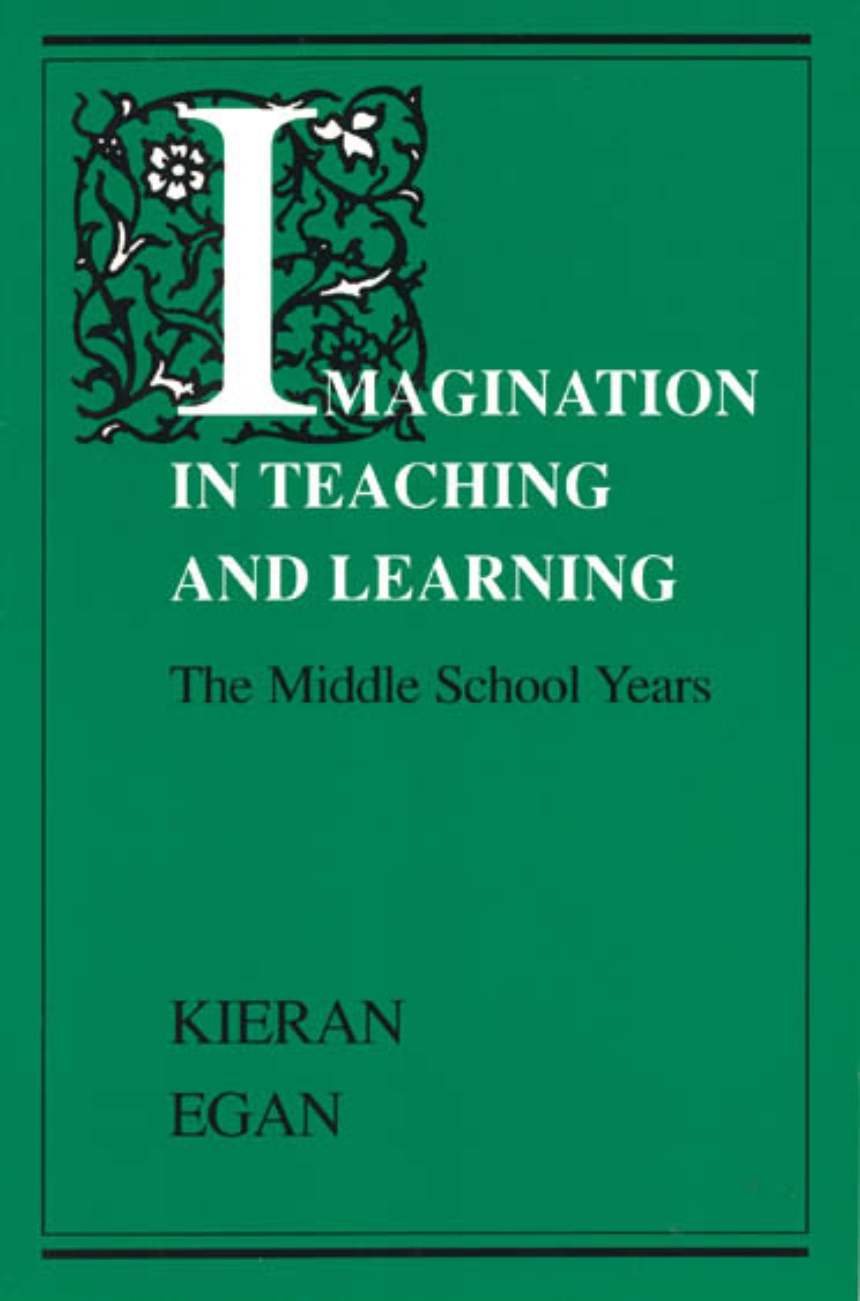Imagination in Teaching and Learning
The Middle School Years
It is widely believed that a child’s imagination ought to be
stimulated and developed in education. Yet, few teachers
understand what imagination is or how it lends itself to
practical methods and techniques that can be used easily in
classroom instruction. In this book, Kieran Egan—winner of
the prestigious Grawemeyer Award for his work on
imagination—takes up where his Teaching as Story Telling
left off, offering practical help for teachers who want to
engage, stimulate, and develop the imaginative and learning
processes of children between the ages of eight to fifteen.
This book is not about unusually imaginative students and
teachers. Rather, it is about the typical student’s
imaginative life and how it can be stimulated in learning,
how the average teacher can plan to achieve this aim, and how
the curriculum can be structured to help achieve this aim.
Slim and determinedly practical, this book contains a wealth
of concrete examples of curriculum design and teaching
techniques structured to appeal specifically to children in
their middle school years.
stimulated and developed in education. Yet, few teachers
understand what imagination is or how it lends itself to
practical methods and techniques that can be used easily in
classroom instruction. In this book, Kieran Egan—winner of
the prestigious Grawemeyer Award for his work on
imagination—takes up where his Teaching as Story Telling
left off, offering practical help for teachers who want to
engage, stimulate, and develop the imaginative and learning
processes of children between the ages of eight to fifteen.
This book is not about unusually imaginative students and
teachers. Rather, it is about the typical student’s
imaginative life and how it can be stimulated in learning,
how the average teacher can plan to achieve this aim, and how
the curriculum can be structured to help achieve this aim.
Slim and determinedly practical, this book contains a wealth
of concrete examples of curriculum design and teaching
techniques structured to appeal specifically to children in
their middle school years.
188 pages | 5-1/4 x 8 | © 1992
Education: Curriculum and Methodology, Pre-School, Elementary and Secondary Education
Table of Contents
Acknowledgments
Introduction
A Very Short History of the Imagination
Introduction
Myth, Memory, and Emotion
Ancient and Medieval Imagination
Imagination in the Enlightenment
The Romantic Imagination
Imagination in the Modern Period: Philosophical Work
Imagination in the Modern Period: Psychological Work
Conclusion
Why is Imagination Important to Education?
Introduction
Imagination and Conventional Thinking
Imagination in Learning
Imagination and Memory
Social Virtues
Imagination and Freedom
Imagination and Objective Knowledge
Visualization, Originality, and Creativity
The Narrative Mind
Conclusion
III. Characteristics of Students’ Imaginative Lives, Ages 8-15
Introduction
The Affective Connection
Extremes and Limits
Romance, Wonder, and Awe
Associating With the Heroic
Revolt and Idealism
Matters of Detail
Humanizing Knowledge
Conclusion
IV. Imagination and Teaching
Introduction
A Planning Framework For Imaginative Teaching and Learning
Exploration of the Framework by Means of an Example
Less Formal Implementations: Fragmenting the Framework
From Characteristics to Principles of Learning
Conclusion
VI. Image and Concept
Some Further Examples
Introduction
Mathematics
Science
Social Studies
Language Arts
Conclusion
Conclusion
The Role of the Teacher
The Imaginative Curriculum
Eliminating Social Studies and Humanities
Imagination and Entertainment
Interests and Abilities: Educational Clichés
The Moral Dimension
The Logic of the Heart
References
Index
Introduction
A Very Short History of the Imagination
Introduction
Myth, Memory, and Emotion
Ancient and Medieval Imagination
Imagination in the Enlightenment
The Romantic Imagination
Imagination in the Modern Period: Philosophical Work
Imagination in the Modern Period: Psychological Work
Conclusion
Why is Imagination Important to Education?
Introduction
Imagination and Conventional Thinking
Imagination in Learning
Imagination and Memory
Social Virtues
Imagination and Freedom
Imagination and Objective Knowledge
Visualization, Originality, and Creativity
The Narrative Mind
Conclusion
III. Characteristics of Students’ Imaginative Lives, Ages 8-15
Introduction
The Affective Connection
Extremes and Limits
Romance, Wonder, and Awe
Associating With the Heroic
Revolt and Idealism
Matters of Detail
Humanizing Knowledge
Conclusion
IV. Imagination and Teaching
Introduction
A Planning Framework For Imaginative Teaching and Learning
Exploration of the Framework by Means of an Example
Less Formal Implementations: Fragmenting the Framework
From Characteristics to Principles of Learning
Conclusion
VI. Image and Concept
Some Further Examples
Introduction
Mathematics
Science
Social Studies
Language Arts
Conclusion
Conclusion
The Role of the Teacher
The Imaginative Curriculum
Eliminating Social Studies and Humanities
Imagination and Entertainment
Interests and Abilities: Educational Clichés
The Moral Dimension
The Logic of the Heart
References
Index
